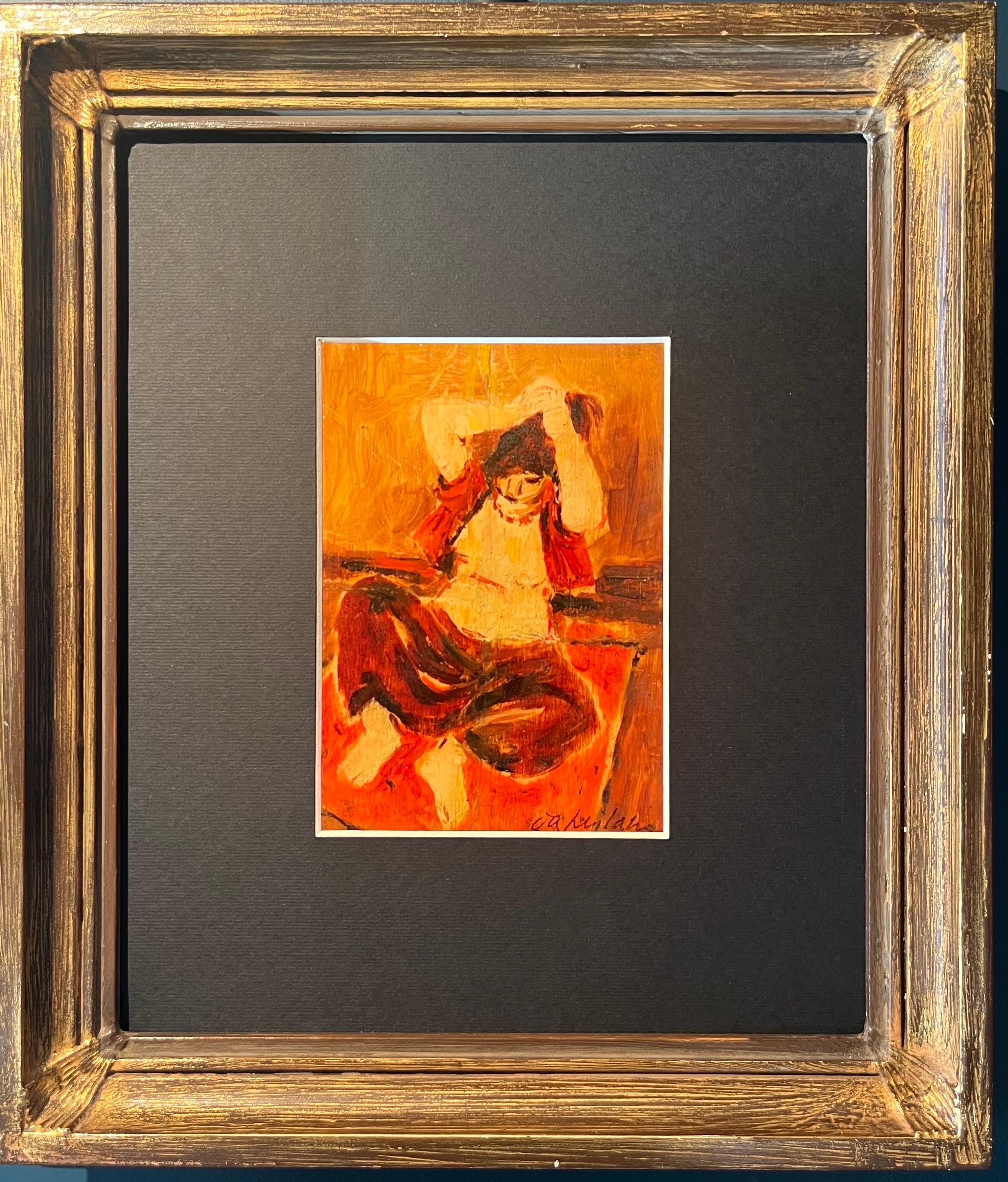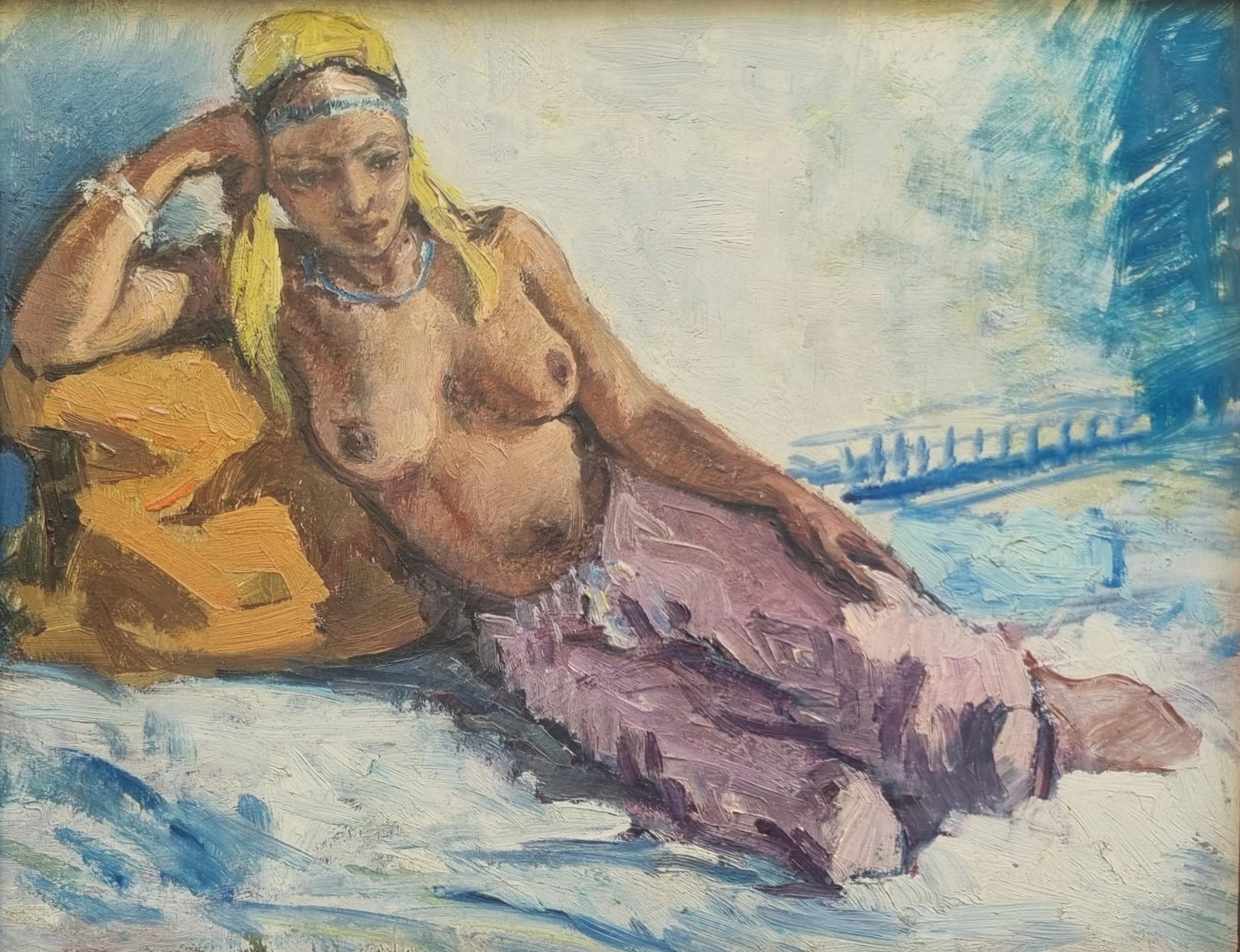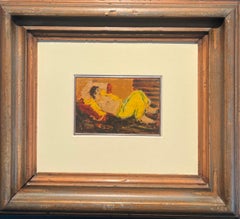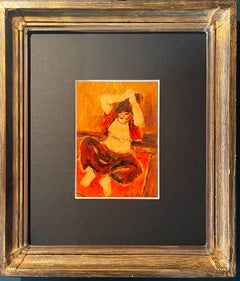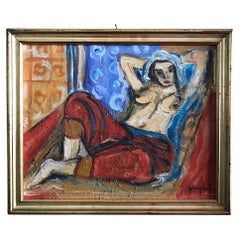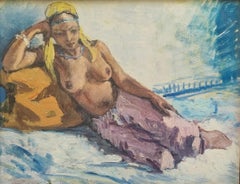Items Similar to "Odalisque yellow" Oil , cm. 40 x 50 1937 free shipping
Video Loading
Want more images or videos?
Request additional images or videos from the seller
1 of 10
Giulio da Milano"Odalisque yellow" Oil , cm. 40 x 50 1937 free shipping1937
1937
$6,547.84
$8,184.8020% Off
£4,763.48
£5,954.3520% Off
€5,440
€6,80020% Off
CA$8,935.92
CA$11,169.9020% Off
A$9,950.95
A$12,438.6920% Off
CHF 5,178.92
CHF 6,473.6520% Off
MX$122,694.01
MX$153,367.5120% Off
NOK 65,957.50
NOK 82,446.8720% Off
SEK 61,993.65
SEK 77,492.0720% Off
DKK 41,400.93
DKK 51,751.1720% Off
Shipping
Retrieving quote...The 1stDibs Promise:
Authenticity Guarantee,
Money-Back Guarantee,
24-Hour Cancellation
About the Item
Odalisque ,yellow,orange, orient
Giulio DA MILANO (Nizza, 1895 - Torino, 1990)
Giulio Da Milano was a Giacomo Grosso's disciple and he was very close to the artists that used to patronize La Coupole de Montparnasse (from Kisling to Pascin, from Derain to Vlaminck). He is considered one of most representative exponents of the Turin’s artistic scene in the ‘30s-‘40s, close to the Gruppo dei Sei. His works can be found in the following museums:
Turin, Modern Art Gallery
Milan, Modern Art Gallery
Rome, National Modern Art Gallery
Nice, Musée des Beaux-Arts
Works by Giulio Da Milano are permanently dealt by the Pirra Art Gallery and are published in coloured monographs edited by the Gallery.
- Creator:Giulio da Milano (Nice, 1895 - Turin, 1990, Italian)
- Creation Year:1937
- Dimensions:Height: 30.32 in (77 cm)Width: 18.12 in (46 cm)
- Medium:
- Movement & Style:
- Period:
- Condition:
- Gallery Location:Torino, IT
- Reference Number:1stDibs: LU537310890802
About the Seller
4.9
Gold Seller
Premium sellers maintaining a 4.3+ rating and 24-hour response times
Established in 1969
1stDibs seller since 2017
132 sales on 1stDibs
Typical response time: <1 hour
- ShippingRetrieving quote...Shipping from: TORINO, Italy
- Return Policy
Authenticity Guarantee
In the unlikely event there’s an issue with an item’s authenticity, contact us within 1 year for a full refund. DetailsMoney-Back Guarantee
If your item is not as described, is damaged in transit, or does not arrive, contact us within 7 days for a full refund. Details24-Hour Cancellation
You have a 24-hour grace period in which to reconsider your purchase, with no questions asked.Vetted Professional Sellers
Our world-class sellers must adhere to strict standards for service and quality, maintaining the integrity of our listings.Price-Match Guarantee
If you find that a seller listed the same item for a lower price elsewhere, we’ll match it.Trusted Global Delivery
Our best-in-class carrier network provides specialized shipping options worldwide, including custom delivery.More From This Seller
View All"Yellow odalisque" cm. 15 x 10 1925
By Giulio da Milano
Located in Torino, IT
odalisque, yellow, orient
Giulio DA MILANO (Nizza, 1895 - Torino, 1990)
Giulio Da Milano was a Giacomo Grosso's disciple and he was very close to the artists that used to patronize...
Category
1920s Expressionist Figurative Paintings
Materials
Oil
$2,888 Sale Price
20% Off
"Red Odalisque" oil cm. 17 x 12 1947 Offer Free Shipping
By Giulio da Milano
Located in Torino, IT
red, odalisque,orange,yellow
Giulio DA MILANO (Nizza, 1895 - Torino, 1990)
Giulio Da Milano was a Giacomo Grosso's disciple and he was very close to the artists that used to patronize La Coupole de Montparnasse (from Kisling to Pascin, from Derain to Vlaminck). He is considered one of most representative exponents of the Turin’s artistic scene in the ‘30s-‘40s, close to the Gruppo dei Sei. His works can be found in the following museums:
Turin, Modern Art Gallery...
Category
1940s Expressionist Figurative Paintings
Materials
Wood Panel
$2,888 Sale Price
20% Off
Free Shipping
"Bambina in giallo " Olio cm. 55 x 60 2007
By Igor SMEKALOV
Located in Torino, IT
Figura di bambina gialla
Bellissima cornice in legno
Category
Early 2000s Contemporary Portrait Paintings
Materials
Canvas, Oil
" Orange Nude "Oil cm. 25 x 60 1952
By Edgardo Corbelli
Located in Torino, IT
Italy,Italian Painter,Women,Nude,Orange,Red ,1952
Edgardo CORBELLI (Turin, 1918 - 1989)
From the traditional composition of the 1930s, the painting of Corbelli leads to technical a...
Category
1950s Expressionist Nude Paintings
Materials
Oil
"Blue nude" 1953 Oil cm. 50 x 60
By Edgardo Corbelli
Located in Torino, IT
Blue Nude, 1953
Oil on canvas
Signed and dated upper right
Edgardo CORBELLI (Turin, 1918 - 1989)
From the traditional composition of the 1930s, the painting of Corbelli leads to tec...
Category
1950s Expressionist Nude Paintings
Materials
Canvas, Oil
"Angela" Oil cm. 100 x 70 1979
By Edgardo Corbelli
Located in Torino, IT
Woman reclining, pink
we send the work anywhere
Edgardo CORBELLI (Turin, 1918 - 1989)
From the traditional composition of the 1930s, the painting of Corbelli leads to technical and ...
Category
1970s Expressionist Figurative Paintings
Materials
Canvas, Oil
You May Also Like
Contemporary Painting, French Artist, Matisse Style Odalisque
Located in Munich, DE
Matisse is commonly regarded, along with Pablo Picasso, as one of the artists who best helped to define the revolutionary developments in the visual ...
Category
20th Century French Paintings
Materials
Acrylic
Orientalist Painting 20th Art deco Odalisque Woman nude Wood panel
Located in PARIS, FR
French School of the 20th Century
An Odalisque in Marocco
Oil on wood panel
27 x 34.5 cm (43 x 51 cm with the frame)
Beautiful solid wood frame
Exhibition stamp (number 23) on the fr...
Category
20th Century Art Deco Nude Paintings
Materials
Oil
Reclined Nude - Oil Paint by Antonio Feltrinelli - 1930s
By Antonio Feltrinelli
Located in Roma, IT
Reclined Nude with Parrot is an original artwork realized by the Italian artist Antonio Feltrinelli in 1930s.
Oil on canvas
Beautiful and representative artwork depicting a reclin...
Category
1930s Modern Figurative Paintings
Materials
Oil
Afternoon, Modern Portrait Oil Painting by Jan de Ruth
By Jan De Ruth
Located in Long Island City, NY
Artist: Jan De Ruth, Czech (1922 - 1991)
Title: Afternoon
Year: circa 1965
Medium: Oil on Canvas, signed
Size: 20 x 16 in. (50.8 x 40.64 cm)
Frame Size: 26 x 22 inches
Category
1960s Expressionist Portrait Paintings
Materials
Oil
$7,600 Sale Price
20% Off
"Seated Nude" American Impressionist Portrait of a Woman Oil on Board Painting
By Louis Bouché
Located in New York, NY
This is a wonderful example of Louis Bouché's charming Nude portraits. The artist was truly a master of capturing the energy of the times, and character o...
Category
Mid-20th Century American Impressionist Nude Paintings
Materials
Board, Oil
Woman on Sofa - Oil Paint by Antonio Feltrinelli - 1930s
By Antonio Feltrinelli
Located in Roma, IT
Woman on Sofa is a modern artwork realized by Antonio Feltrinelli in the 1930s.
Another painting of human figure on rear.
Includes frame.
Mixed colored oil painting on canvas
Antonio Feltrinelli (Milan, 1887 – Gargnano, 1942)
He was born in Milan on June 1, 1887 to Giovanni Feltrinelli, the nephew of Giacomo, who was the founder of the Feltrinelli partnership. Feltrinelli was not only a prominent figure in the Italian economic and financial field, but he was also a painter, who was characterized as a strong, impetuous hot colorist, and preferred still lifes, portraits and landscapes. He started his career in 1930 at La Permanente (Milan), where he exhibited a portrait and a still life that won him the Fornara award.
That same year, Feltrinelli exhibited his work at the Venice Biennial and at the Pesaro Gallery in Milan. Together with other prominent avant-garde artists, he participated in various foreign exhibitions on modern Italian painting...
Category
1930s Modern Figurative Paintings
Materials
Oil
More Ways To Browse
Odalisque Paintings
La Coupole
Grosso Giacomo
Egypt Palm
Oil Drum
Oil Painting Priest
Muller Oil Painting
Anthropomorphic Oil Painting
Bergdorf Goodman Display
Oyster Oil Paintings
St Denis
Bruno Paoli
Double Bass Vintage
Oil Painting Of Donkeys
Oil Paintings Of African American Woman
Antique Collier
Beaver Art
Female Goddess Painting

